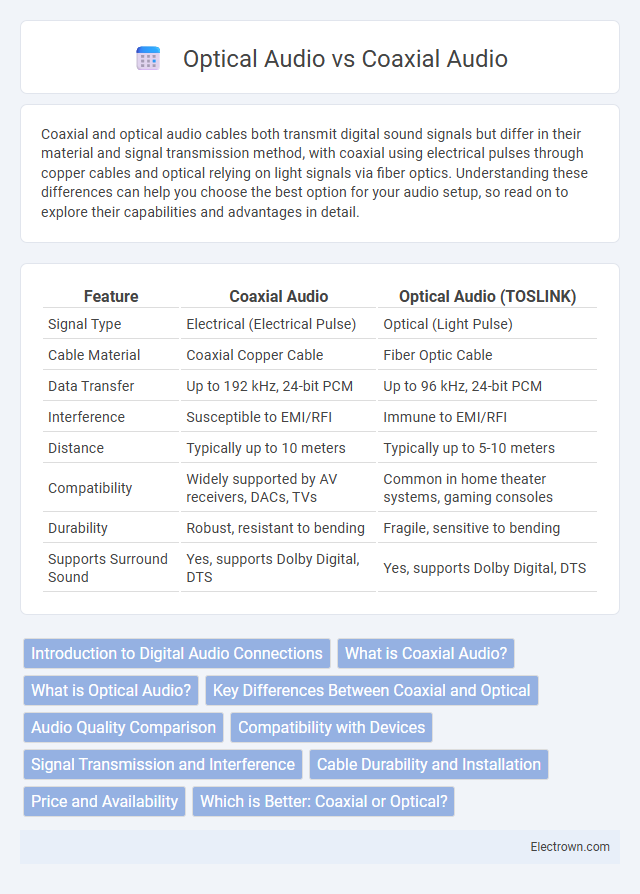Coaxial and optical audio cables both transmit digital sound signals but differ in their material and signal transmission method, with coaxial using electrical pulses through copper cables and optical relying on light signals via fiber optics. Understanding these differences can help you choose the best option for your audio setup, so read on to explore their capabilities and advantages in detail.
Table of Comparison
| Feature | Coaxial Audio | Optical Audio (TOSLINK) |
|---|---|---|
| Signal Type | Electrical (Electrical Pulse) | Optical (Light Pulse) |
| Cable Material | Coaxial Copper Cable | Fiber Optic Cable |
| Data Transfer | Up to 192 kHz, 24-bit PCM | Up to 96 kHz, 24-bit PCM |
| Interference | Susceptible to EMI/RFI | Immune to EMI/RFI |
| Distance | Typically up to 10 meters | Typically up to 5-10 meters |
| Compatibility | Widely supported by AV receivers, DACs, TVs | Common in home theater systems, gaming consoles |
| Durability | Robust, resistant to bending | Fragile, sensitive to bending |
| Supports Surround Sound | Yes, supports Dolby Digital, DTS | Yes, supports Dolby Digital, DTS |
Introduction to Digital Audio Connections
Coaxial and optical audio cables are primary digital audio connections used to transmit high-quality sound signals between devices such as DVD players, soundbars, and AV receivers. Coaxial cables use electrical signals over a copper wire with RCA connectors, capable of supporting sample rates up to 192 kHz and bit depths of 24 bits. Optical cables, or TOSLINK, utilize fiber optic technology to transmit data as light pulses, providing immunity to electromagnetic interference and supporting similar audio resolutions, making both suitable for home theater and professional audio setups.
What is Coaxial Audio?
Coaxial audio is a digital audio interface that transmits high-quality sound signals using a single RCA cable with a 75-ohm impedance. It supports multichannel audio formats such as Dolby Digital and DTS, making it popular for home theater systems and professional audio equipment. Your choice of coaxial audio ensures minimal signal loss and interference over moderate cable lengths compared to optical connections.
What is Optical Audio?
Optical audio, also known as TOSLINK or digital optical, transmits sound using light signals through fiber optic cables, ensuring minimal interference and high-quality digital sound transfer. It supports multi-channel audio formats such as Dolby Digital and DTS, making it ideal for home theater systems and gaming consoles. Optical audio cables provide electrical isolation, reducing noise and signal degradation compared to coaxial audio cables.
Key Differences Between Coaxial and Optical
Coaxial audio cables use copper wiring to transmit electrical digital signals, offering robust durability and typically supporting sample rates up to 192 kHz. Optical audio cables use fiber optic strands to transmit digital signals as pulses of light, providing immunity to electromagnetic interference and longer cable run capability without signal degradation. Key differences include signal transmission medium, susceptibility to interference, and maximum supported cable length, influencing choice based on audio setup requirements and environmental factors.
Audio Quality Comparison
Coaxial audio cables transmit digital signals using electrical pulses, while optical cables use light to carry audio data, minimizing electromagnetic interference and signal degradation. Optical audio tends to provide clearer sound quality with reduced noise, especially over longer distances, but high-quality coaxial cables can deliver comparable performance in short runs. Your choice between coaxial and optical audio should consider the specific audio equipment compatibility and the environment where signal interference might impact sound fidelity.
Compatibility with Devices
Coaxial audio cables are widely compatible with older and many modern home theater systems, DVD players, and gaming consoles due to their reliance on RCA connectors. Optical audio (Toslink) is favored in devices emphasizing digital audio quality, such as high-end soundbars, AV receivers, and some TVs, offering resistance to electromagnetic interference. Both formats support multi-channel audio but device compatibility varies; checking specific input/output options is essential for optimal audio performance.
Signal Transmission and Interference
Coaxial audio cables transmit digital signals using electrical pulses over copper wires, which can be susceptible to electromagnetic interference (EMI) and signal degradation over long distances. Optical audio cables, also known as TOSLINK, use light pulses through fiber optic strands, providing superior immunity to EMI and maintaining signal integrity across longer runs. Choosing optical audio ensures your signal transmission remains clean and free from electrical noise, especially in environments with multiple electronic devices.
Cable Durability and Installation
Coaxial audio cables feature robust, thick copper shielding that offers high durability and resistance to physical damage, making them ideal for long-term installations where cable protection is crucial. Optical cables, while more fragile due to their fiber optic core, provide flexibility and immunity to electromagnetic interference, which can simplify installation in environments with heavy electronic equipment. For your setup, coaxial cables ensure a sturdy and reliable physical connection, whereas optical cables offer a clean, interference-free signal path with careful handling during installation.
Price and Availability
Coaxial audio cables are generally more affordable and widely available compared to optical cables, making them a cost-effective option for most users. Optical cables, while slightly pricier, offer superior immunity to electromagnetic interference and are commonly used in high-end audio setups. Your choice depends on your budget and the availability of compatible ports on your audio devices.
Which is Better: Coaxial or Optical?
Coaxial audio cables offer better bandwidth and signal integrity due to their copper core, making them ideal for high-quality digital audio transmission up to 24-bit/192kHz. Optical cables use fiber optics to transmit audio via light, providing excellent resistance to electromagnetic interference but often limited to the same maximum quality as coaxial cables. For systems prioritizing minimal interference and electrical isolation, optical is preferable, while coaxial is better suited for the highest-fidelity audio performance in home theater setups.
coaxial vs optical audio Infographic

 electrown.com
electrown.com